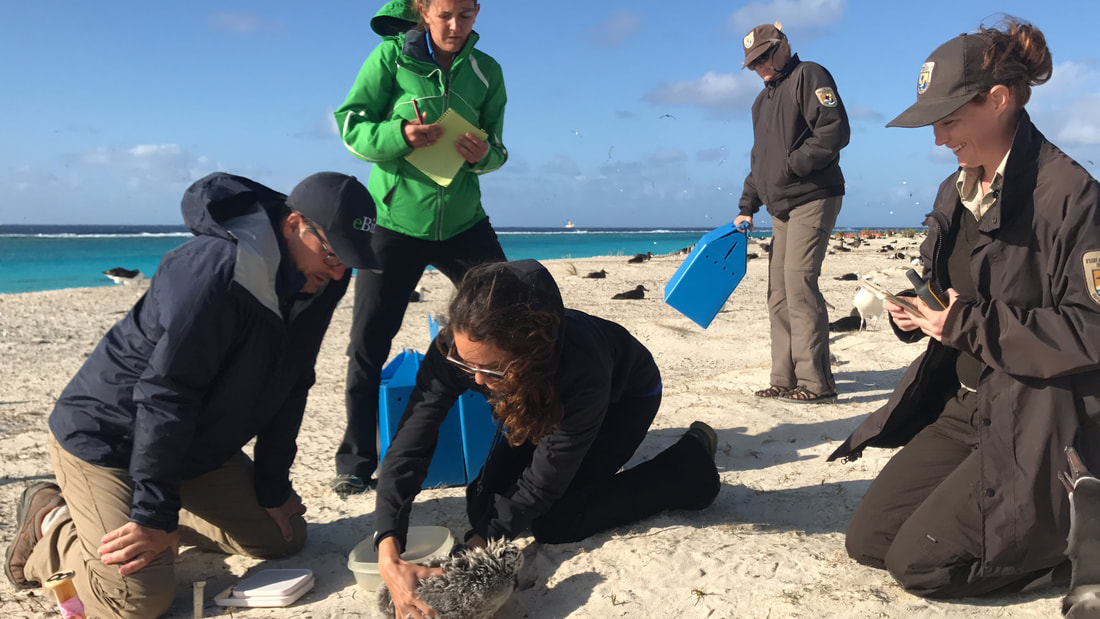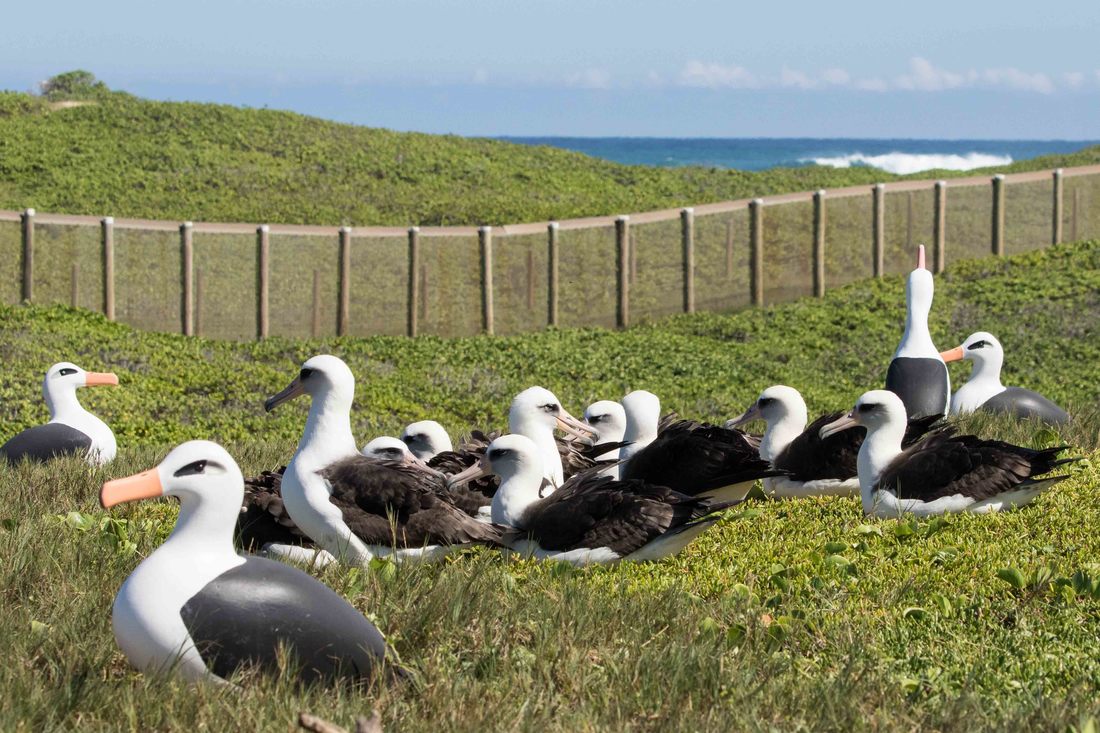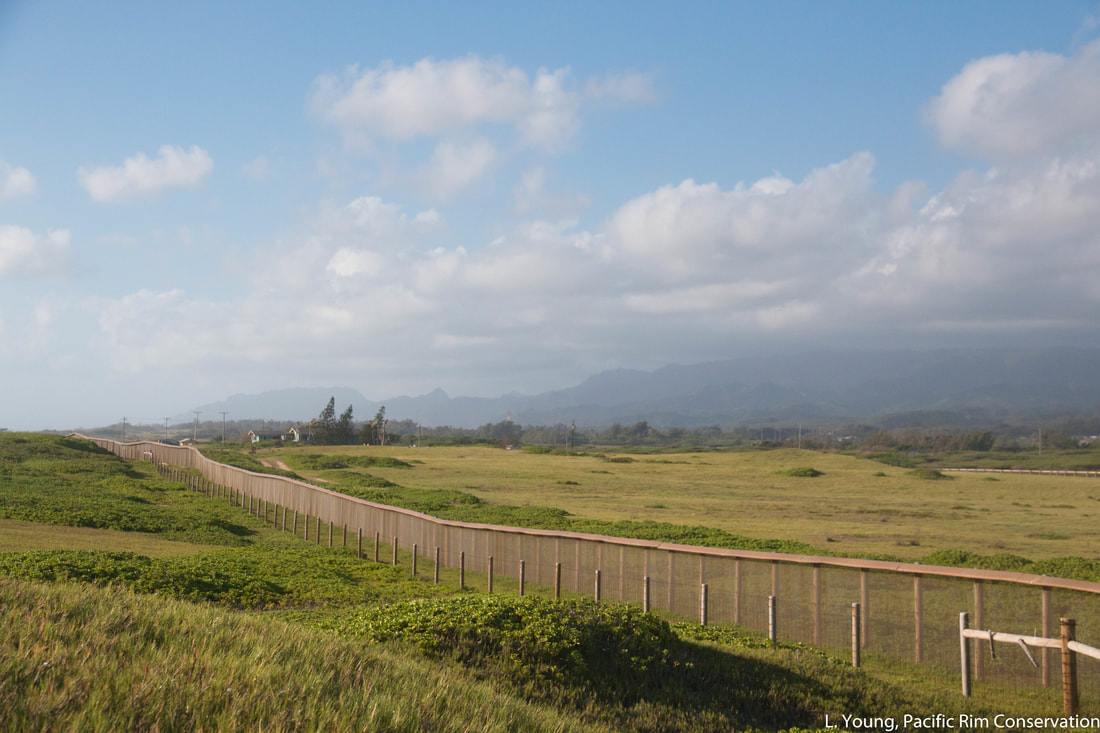|
Mainland islands are sites on larger islands where predators have been removed and excluded through fencing, or are permanently controlled in order to provide safe breeding locations for threatened island species. We do this by protecting habitat, removing invasive species, and then attracting or translocating bird species into these areas.
Seabird translocationTranslocation is the moving of a species from one location to another to start a new colony. We move chicks of imperiled bird species before they have imprinted on their birth colony, and hand-raise them at their new colony (within the predator proof fences) until they are adults. They will then imprint on their new colony and return to breed as adults and create a new colony. For more information on how that works, check out the video below on our Black-footed Albatross translocation and download our faq:
| |||||||
Social attraction
We rely on some birds species natural instincts to colonize areas where they see other members of their species. We do this by placing decoys (seen below) and broadcasting their calls from large speakers to ‘call them in’ and encourage adult birds to nest. However, social attraction is only effective when there are enough birds in the area to be lured in. When social attraction isn't effective, we rely on translocation. Read more about our social attraction results here.
Predator exclusion fencing
We protect and restore habitat to create mainland islands in two ways: one is removing invasive species from offshore islands, and the second is building predator-proof fences (seen above) to create predator-free "mainland islands" within inhabited islands. Predator proof fences are tall enough to prevent animals from jumping over, have a hood to prevent animals from climbing over, mesh that is small enough even mice can’t squeeze through and has a skirt underground that prevents them from digging in. All of the materials are marine grade stainless steel to ensure that the fences last in harsh coastal environments. You can download an faq on how predator exclusion fencing works below, and read more about how this is done here and how this benefits native birds here and here.
| predator_fence_faq.pdf | |
| File Size: | 843 kb |
| File Type: | |
Locations
The current focal site of the No Net Loss initiative is at James Campbell National Wildlife Refuge, owned by the U.S. Fish and Wildlife Service, on the North Shore of Oahu, Hawaii, USA. James Campbell National Wildlife Refuge protects some of Hawaii's most productive wetland habitats, and is one of the few protected coastal dune ecosystems on Oahu anticipated to withstand projected sea level rises. In 2016 a 16 acre predator proof fence (pictured above), capable of excluding all mammalian predators, was constructed around a portion of this dune habitat to provide a safe refuge for seabirds and coastal plants. While this fence may seem small, it is 75% of the nesting area on Tern Island in Papahanaumokuakea Marine National Monument, which is home to more than 8,000 nesting pairs of albatrosses, and 235,000 breeding pairs of other seabird species. In short, a lot of birds can fit into 16 acres!
Since 2015, 509 individuals of our four focal species have been translocated to James Campbell National Wildlife Refuge, and thousands of wild adults have visited in an attempt to create a new, safe, high-island colony for these species. Three of our four focal species now nest on the refuge (see the species tab for current numbers).
On the North Western tip of Oahu, a 59 acre site at Kaena Point Natural Area Reserve owned by the state of Hawaii has been used as a social attraction site since 2011, when the predator proof fence at that site was completed. Kaena Point is one of the most intact coastal dune ecosystems in Hawaii, and is home to several thousand breeding seabirds already. Planning is underway to bring more species to this site in future years.
Finally, on the island of Kauai, a predator proof fence was built at Kilauea Point National Wildlife Refuge in 2014 to serve as a translocation site for the endemic Newell's Shearwater and Hawaiian Petrels which were successfully translocated to the site and now breed as adults. For more on that project visit www.nihoku.org. This site may be used in the future for sea level rise vulnerable species.
On the North Western tip of Oahu, a 59 acre site at Kaena Point Natural Area Reserve owned by the state of Hawaii has been used as a social attraction site since 2011, when the predator proof fence at that site was completed. Kaena Point is one of the most intact coastal dune ecosystems in Hawaii, and is home to several thousand breeding seabirds already. Planning is underway to bring more species to this site in future years.
Finally, on the island of Kauai, a predator proof fence was built at Kilauea Point National Wildlife Refuge in 2014 to serve as a translocation site for the endemic Newell's Shearwater and Hawaiian Petrels which were successfully translocated to the site and now breed as adults. For more on that project visit www.nihoku.org. This site may be used in the future for sea level rise vulnerable species.


